#anti gerry conway
Explore tagged Tumblr posts
Text
I have when characters in comics (or movies or books or etc) get killed off. There's only one real time when I'm okay with death in fiction: if you kill off characters nobody cares about (like killing off someone's parents as part of their backstory, or killing a minor character we'll only see a small number of times). When you kill these characters, I don't feel as bad as I do when major characters die. But if you kill off a hero, villian or even just a supporting character, i will notice. And if I like the character (and i usually seem to), then i will not forgive you.
Jim Starlin gets all the hate for killing off Captain Mar-Vell and Jason Todd. Shame on Gerry Conway for killing off Gwen Stacy and The Eel (sure, the eel was a minor villian. But you could have done more with him)! Mark Gruenwald forced marvel to kill off a series of minor villians, and i want to punch him for that! Why do you kill them!? You could've let them merely lapse into obscurity, but no! You couldn't do that! No, kill them instead! You idiots!
#I hate death in fiction#the deaths are usually wastes of good characters!#It's always a waste!#it's awful#comics#comic books#marvel#dc#marvel comics#dc comics#anti jim starlin#anti gerry conway#anti mark gruenwald#captain marvel#captain mar vell#mar vell#gwen stacy#jason todd#red hood
25 notes
·
View notes
Text
Now, I've mostly been making Batfamily related blog posts, but I want to talk a little about something different.
Now, Spider-Man is quite literally my favorite character in not just comics but all of fiction. I just got done reading The Amazing Spider-Man: Parallel Lives, and it was great!
I may say this should be on any essential reading list for anyone interested in Spider-Man, Mary Jane, and their relationship. Also, it should be shown to anyone online before they say anything about MJ. I think this would help stop most of the bad takes and misconceptions people have about her.
I love the two of them together, and this book does a pretty good job at showing why they work.
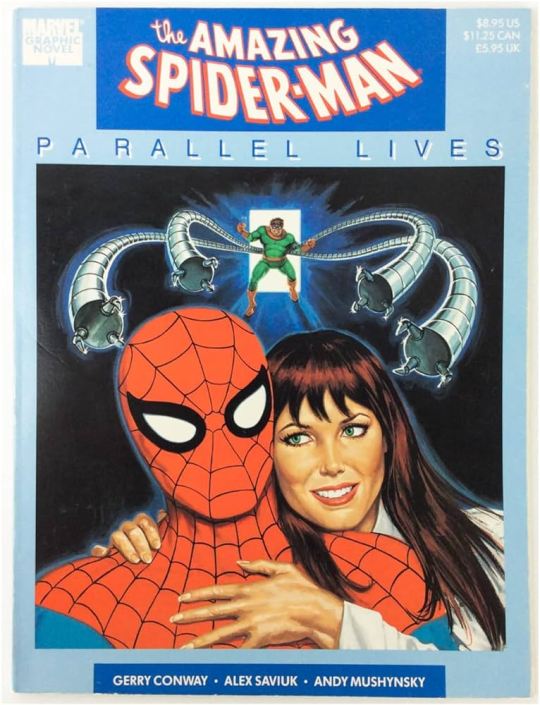
Also, Doc Ock's in it, and he's used pretty well. It was not his best appearance, but it was still a pretty good one.
Below are just a couple of pages from the story. Read them if you want to, but if you would prefer to go into the story blind, then, of course, don't.
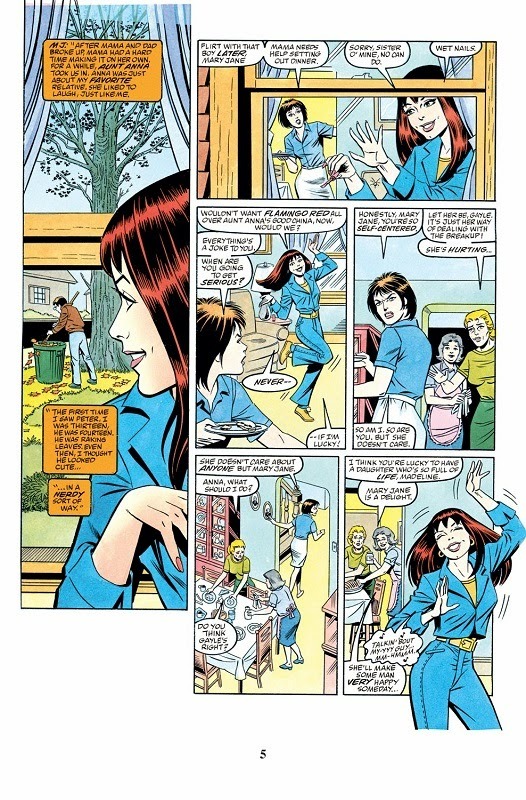
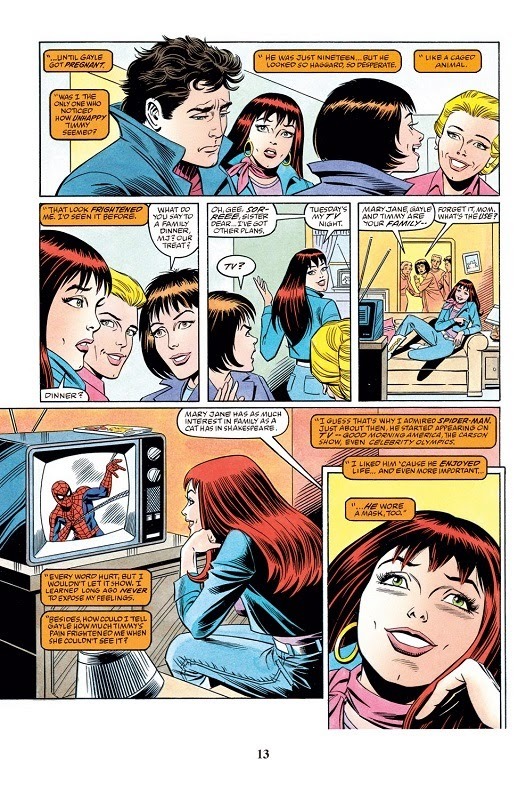
#marvel#comics#marvel comics#marvel graphic novel#the amazing spider-man parallel lives#spider man#peter parker#mary jane watson#mary jane parker#peter and mj#petermj#peter x mj#peter x mary jane#undo one more day#anti one more day#spider marriage#doctor octopus#doc ock#otto octavius#gerry conway#alex saviuk#andy mushynsky#why are you still here#go read this#if you haven't already#comic review#short review
20 notes
·
View notes
Text




"The vigilante anti-hero is fundamentally a critique of the justice system, an example of social failure, so when cops put Punisher skulls on their cars or members of the military wear Punisher skull patches, they're basically sides with an enemy of the system. They are embracing an outlaw mentality. Whether you think the Punisher is justified or not, whether you admire his code of ethics, he is an outlaw. He is a criminal. Police should not be embracing a criminal as their symbol. In a way, it's as offensive as putting a Confederate flag on a government building. My point of view is, the Punisher is an anti-hero, someone we might root for while remembering he's also an outlaw and criminal. If an officer of the law, representing the justice system puts a criminal's symbol on his police car, or shares challenge coins honoring a criminal he or she is making a very ill-advised statement about their understanding of the law." - Gerry Conway (Co-creator of The Punisher)
The Punisher #13
#just so we're fucking clear#really glad that daredevil: born again is exploring the topic#the punisher#frank castle#nypd#marvel comics#fuck the police#matt reads a thing#i posted this
13 notes
·
View notes
Text
It has been over 17 years since One More Day.
During that time we have had:
The equivalent of 6 runs on Amazing Spider-Man, if one counts Brand New Day and the Beyond era as runs unto themselves.
Several runs in sister titles like Avenging Spider-Man, Superior Spider-Man Team-Up, Friendly Neighborhood Spider-Man, Spectacular Spider-Man, etc
Over 300 issues of ASM, even if one discounts Superior, which Marvel themselves do not
All of this is frankly MORE than enough ‘field testing’ for us to look back with the benefit of hindsight and draw some conclusions. And those conclusions are rather damning.
Whilst it was objectively bad, Superior Spider-Man is the most remembered and referenced and (undeservedly) well received period of time in the post-OMD era. This means the ‘highlight’ (if you want to call that vile story such a thing) is a time period that Peter Parker wasn’t even the main character of the narrative
We have literally had TWO eras where Peter Parker is not even the main character of Spider-Man. Superior, and Beyond
Dan Slott’s run invested time in redressing mistakes perpetuated during Brand new Day, and Nick Spencer’s run spent A LOT of time repairing damage done in BND and Slott’s run.
In the entire 60+ year history of Spider-Man who have been the writer’s with the most ‘prestige’ attached to their name in the wider culture, not specifically within the comic book industry? Who has the ‘star power’ in other words? Kevin Smith for a mini-series in the early-mid 2000s that was just 6 issues (his 2020s Spider-Man work will be happening when his star has fallen into disgrace) and J. Michael Straczynski. In other words, despite the claims that an unmarried Spider-Man will attract more ‘high profile talent’, none of the talent who has worked on 616 Spidey since 2007 has ever had a profile remotely as prestigious as the person who was writing Spidey pre-OMD and wanted to write him married. And again, the second highest profile guy was also writing him pre-OMD.
The ‘high profile talent’ Spidey attracted frankly was front loaded and obviously hired to offset the fallout from OMD. Spider-Man even during BND, saw an exodus of ‘Big Name Creators’ with Slott hanging on until the end of BND and then getting his solo run. Since then it took over 10 years for Joe Kelly to return to the title and in the interim the Spider-Man office got so desperate they hired a fill-in writer from the 2000s, Zeb Wells, to take over ASM. So, actually Spider-Man has had MORE trouble attracting talent long-term post-OMD than pre-OMD. Whilst this is to an extent a problem in the mainstream industry, it is particularly acute with Spider-Man.
The highest profile writers to have worked on Spider-Man in the 2020s have been JMS for a non-canon one shot (in which he was married) and Jonathan Hickman in a non-canon ongoing (in which he is married with kids and this is the centrepiece of its promotion).
All those creators who worked on BND who said they would prefer to write an unmarried Spider-Man proved themselves summarily unqualified to write for Spider-Man in the first place. They got to write the Spider-Man they wanted and did so via nuclear levels of mischaracterisation, character assassination, plot holes, a disrespect for consistency, a disrespect for the readers time/money/intelligence and tired tropes. They claimed everyone deserved the Spider-Man they grew up with but they never even wrote the Spider-Man they grew up with.
Looking back at the actual best Spider-Man creators of the pre-OMD era (1962-2007) it is striking that ONLY Roger Stern and Marv Wolfman were staunchly anti-marriage. Stern delivered arguably the most consistently great Spider-Man run of all time, whilst Wolfman was a lot more contentious but did lots of good stuff. Gerry Conway might be included in that trio but he has massively vacillated his views on the subject. What I am saying is, the overwhelming majority of people who were accepting or supportive of Spider-Man being married delivered solid-all time great stories. By contrast, the overwhelming majority of people who were opposed to a married Spider-Man delivered at best mediocre stories but more often than not bad stories. I say bad, what I mean is the top 20 WORST Spider-Man stories to have ever been made were largely made by people who are of the anti-marriage camp and largely made after One More Day.
In fact, even if we use the anti-marriage camp’s golden boy, Roger Stern, his best work, whilst awesome, is not on the same level as quality as certain stories delivered by pro-marriage creators. Be honest, removing your own subjective enjoyment from the discussion, on a purely literary level, is the Kid Who Collects Spider-Man or Nothing Can Stop the Juggernaut even remotely close to the same quality level as Kraven’s Last Hunt, which actively utilises Spider-Man’s marital status? No.
Even removing the subject of Spider-Man’s marital status or continuity, 2007-2025 Spider-Man has largely been creatively inconsistent, by which I mean disastrous. These would be the WORST Spider-Man stories of all time all on their own regardless of OMD setting us up for them. Character assassination is rife. Disdain for the customers is a regular occurrence.
Marvel have an institionalised misinterpretation of Spider-Man that requires the rats at the very top to be removed from office. Many of you out there are thinking this is a Nick Lowe problem. It isn’t. It’s a Nick Lowe/Tom Brevoort/Alan Fine/Dan Buckley/C.B. Cebulski problem. They all need to go and NOT be allowed to choose their successors
#Spider-Man#One More Day#Brand new Day#Dan Slott#zeb wells#nick spencer#cb cebulski#Marvel#Marvel Comics#mj watson#mary jane watson#mary jane watson parker
7 notes
·
View notes
Text
Hey, remember that JLU episode titled ‘The Once And Future Thing: Weird Western Tales’ where a couple of JL members ended up stranded in the old West thanks to time travel?
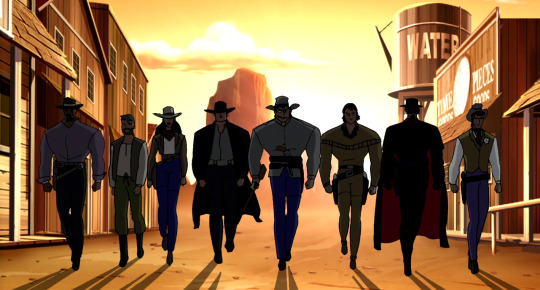
Well, turns out there was a comic book very similar to it written by Gerry Conway with art by Don Heck but starring a different set of JL members which may or may not have been the inspiration for the episode:
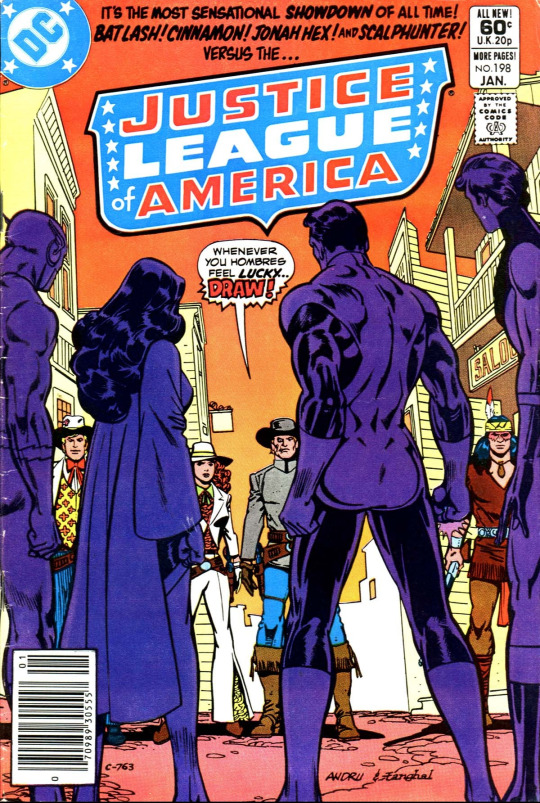
The episode was written by the late Dwayne McDuffie who was no stranger to writing in references to older comics. For instance, the two parter ‘Brave and the Bold’ Flash’s hallucinations were references to various Silver Age Flash comic covers and he was also very open about the fact that the line up for the Terra Beyond two parter was based on Marvel comics Defenders (no not the Netflix team, the one with Namor and Dr Strange). Even the episode title itself, ‘Weird Western Tales’ is a reference to the long running anthology series of the same name featuring DC’s western characters.
The story arc in the comics ran from Justice League of America Vol 1 #198-199.
While it’s hard to conclusively say that the episode was inspired by the comic, there are some interesting similarities like Batlash’s introduction here:
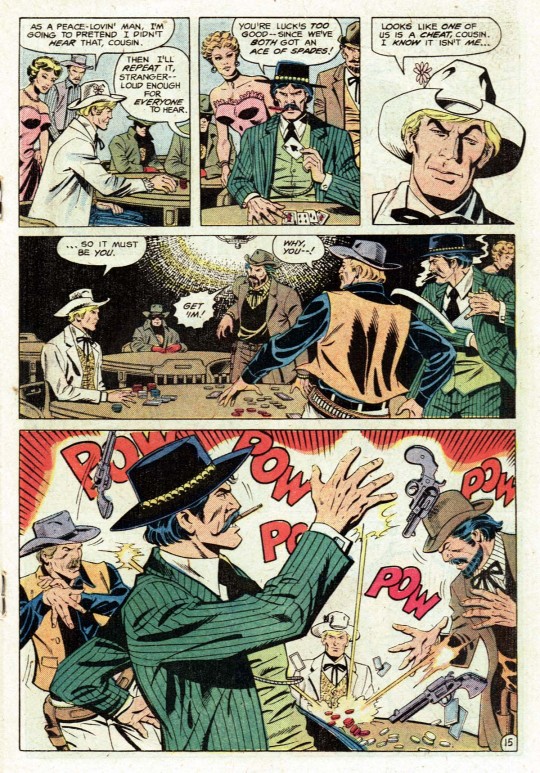
I posted Zatanna’s meeting with Cinnamon earlier in another post but here is a little excerpt:
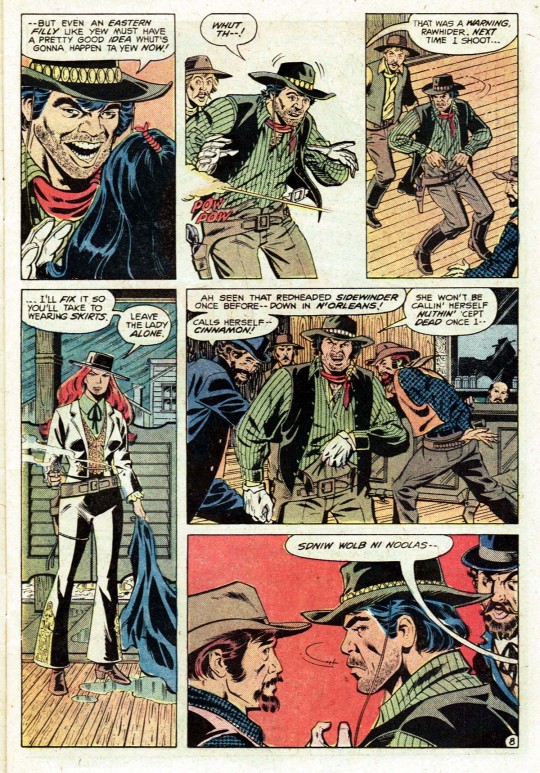
Interesting to note that one of the goons calls her an ‘Eastern Filly’ (is it because of the way she was dressed or a subtle hint that she is not 100% Caucasian?). The heroes and their new Western cowboy friends all meet at a Saloon:

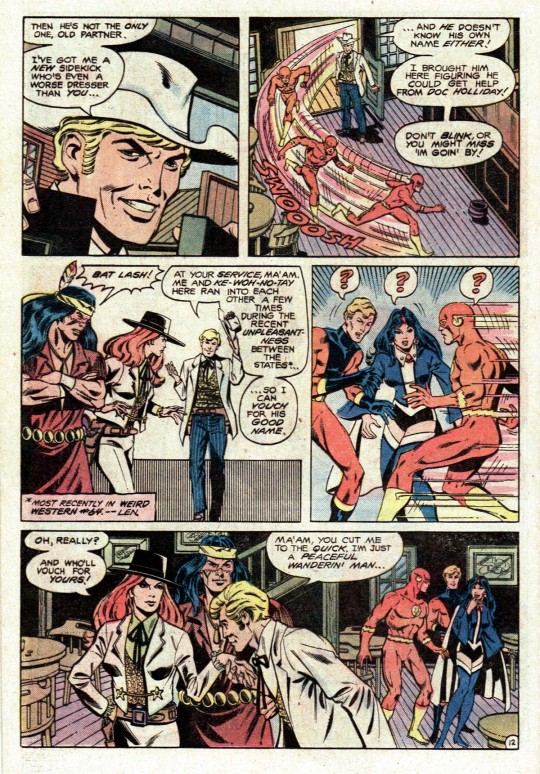
Then they all ride off on horses out of town to confront the villain and of course, faces robot cowboys:

The differences begin with the choice of the time travelling villain, the comic went with classic JL villain: the Lord of Time:

JLU went with David Clinton, aka Chronos. He’s a different villain who is primarily the enemy of the Atom/Ray Palmer but has also fought the JL on occasion.
The Lord of Time on the other hand, is a conqueror from the future who travelled back in time with future technology to conquer the past and rule the future. Sound familiar? He was Kang before Kang. Since JLU’s version of Chronos comes from the future, you could make a case that version is a combination Chronos and Lord of Time.
Then of course, there is the line up, the comic features Zatanna, Elongated Man, Barry Allen and Hal Jordan whereas the show features Wonder Woman, Batman and Green Lantern. Superman also appears trying to thwart the Lord of Time in the present day.
On the Western heroes side, we got Diablo instead of Cinnamon and Scalphunter is replaced by Pow Wow Smith (and it only takes a cursory glance at the characters wikipedia pages to see why the socially conscious Dwayne McDuffie made that choice).
The plot of the JLU episode involved a corrupt sheriff using future technology to take over the town but the plot of the comic is a little different. The Lord of Time sent the heroes back in time, erased their memories, because an anti matter meteor was set to strike earth on that day. The LoT is counting on the heroes to stop the meteor so he can have it for himself so he can use it to conquer the world. (Why he doesn’t just get the meteor himself? Maybe he didn’t have the technology to?)
Anyway, the heroes learn about the anti matter meteor heading towards them, Zatanna is reluctant to leave her new found cowgirl girlfriend with her friends to fight the robots:
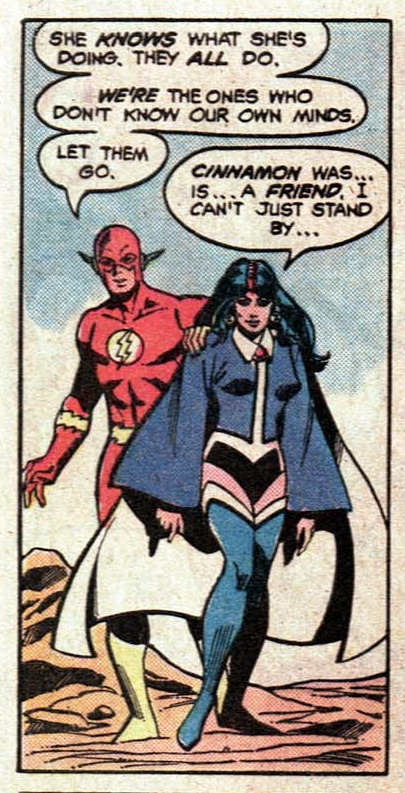
But she ends up going anyway:
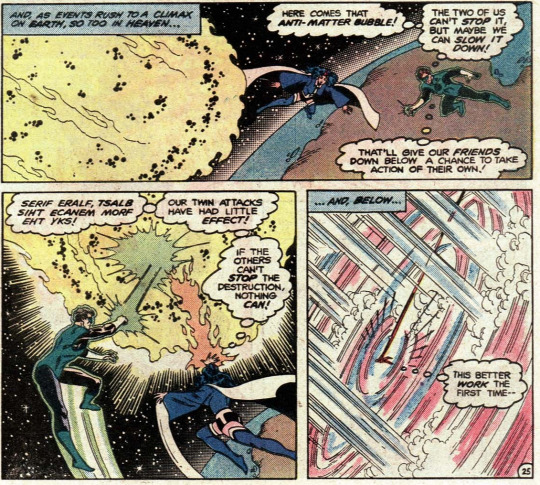
Can I just say, I really like this shot of Zee and Green Lantern flying together? Even though she is depowered during this period, they never really stuck strictly to the ‘she can only manipulate the elements’ ethos. Having her flying alongside GL and being unabashed powerhouse is really cool and shows her place among the DCU. There is no ‘she has to be taken out so someone else can shine’ bs here. Also, reading these comics, I have felt that GL makes the most sense as the field leader of the JL; power based on creativity and will power and they are specifically trained to work together and take on strange extra terrestrial or otherwise threats. I think any of the human GL’s (except maybe Guy) can lead the team.
Zatanna and GL manage to stop the meteor. But in present timeline the Lord of Time ends up defeated by Superman (early on he got in a kryptonite trap set by the LoT but managed to escape) just as the time trapped Leaguers make their way back.
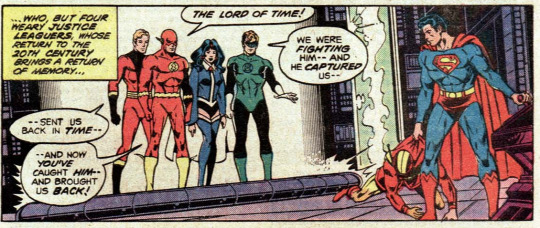
Awww, a krytonite waterfall wasn’t that bad, Clark.
Overall, the issue was alright. It does feel like placeholder (albeit a fun one) before the big #200 celebration issue (I posted some scans from that here). Come to think of it, the episode came off as filler as well, with the Western parts feeling like a fun romp and ultimately inconsequential to the arcs of the main heroes but the follow up portion set in the Batman Beyond timeline was more impactful and memorable.
#zatanna#zatanna zatara#flash#barry allen#green lantern#hal jordan#superman#clark kent#elongated man#ralph dibny#john stewart#justice league of america#jlu#justice league unlimited#dwayne mcduffie#gerry conway#dcau#justice league#justice league of america vol 1#justice league of america 198#justice league of america 199#cinnamon#batlash#scalphunter#ke woh no tay#johnah hex#ohiyesa smith#el diablo#katherine manser
81 notes
·
View notes
Text
I am still reading my way through the Fourth World! Last time I talked about all the stuff published in the 70s; now let's talk about the 80s.
Kirby:
New Gods #12: In 1984, DC reprinted Kirby's original New Gods run and threw in an extra issue (not to be confused with Gerry Conway's New Gods #12) so that Kirby could finish the story. This was partially DC being nice and trying to give an aging Kirby money, and partially not because they refused to let him produce the ending he wanted, which was Orion and Darkseid both dying. After a couple scrapped versions, we got this, in which Orion goes down in a hail of laser fire. It's a real bummer, but at least he's extremely homoerotic with his best buddy Lightray first? (Oh, they're getting a whole separate post, just you wait.)
The Hunger Dogs: This "graphic novel" (it's only 64 pages but back then that counted) came out a year later and was the "conclusion" to the Fourth World saga. Once again DC and Kirby butted heads because Kirby really wanted to kill everyone and DC was like "But our IP!!!" In the final version, only supporting characters Himon and Esak die, which is sad but not going to do any damage to DC's bottom line.
It turns out Orion is not dead despite being riddled with holes (there's an intriguing suggestion that he has some kind of healing ability because he possesses the Life Equation, which like everything else in this book is presented with zero context or explanation), which is great because it gives him an opportunity to be homoerotic with Lightray again, although he has also been given an Obligatory Heterosexual Love Interest, Himon's daughter Bekka.
Anyway this book is baffling. Highfather blows up New Genesis (everyone survives) to taunt Darkseid, who is overthrown by the downtrodden masses of Apokalips. There's some shouting about the dangers of technology and maybe some anti-Cold War rhetoric about stockpiling weapons, but it's all so hysterically overblown - Kirby at his most grandiose - that it's nearly impossible to parse beyond "war bad." I do appreciate that Orion is able to break free of his rage and death wish and just...leave Darkseid behind, but the fact that he's emotionally mature enough to do that now comes pretty much out of nowhere. The art is extremely powerful, at least.
My final thought is that Kirby clearly gleefully ignored everything Englehart, Conway, et al. did and I love that for him.
Super Powers: Darkseid fights the Justice League. This was a comic created to sell a toy line and you can really, really tell.
Post-Kirby:
Legends: I've read this before, but it's great. If you like pre-Flashpoint DC, you should definitely read this, which introduces Amanda Waller and the Suicide Squad, sets up the JLI, and brings Wonder Woman into the post-Crisis DCU. Neither Orion nor Scott are present but this (along with the Happyland issue of the original Forever People) really makes the case for why Glorious Godfrey is one of Kirby's best and scariest Fourth World creations. And I will never complain about John Byrne art.
Forever People (1988): Blecch. It's definitely arrogant to read something and think "I know for certain that Jack Kirby, a man I never met who died when I was a child, would have hated this" but like. I'm right. And it's obvious from the very first page.
Basically, at the end of Kirby's series, the FP were marooned on a random, idyllic planet somewhere with no hope of getting home, so they embraced it as their new, hopeful future. This catches up with them years later, with Serifan (the sweet young kid) drooling and raving alone in the woods, Vykin (the only Black character) dead (he gets better), and the rest of them...living in yuppie paradise? Apparently the planet they ended up on was populated (missing the point) with "primitive" people (racist) so they decided to use Mother Box to forcibly "evolve" the people (SO RACIST) and were able to create...modern-day America? Literally why would they even do that, they're from New Genesis. Mark is mayor and married with kids, and Big Bear and Beautiful Dreamer are married to each other with a baby on the way.
Anyway a nebulous villain/evil force called "the Dark" undoes everything which brings Vykin back to life but takes away Mark's wife and kids (she's alive but still "primitive" and the kids were never born) and Bear and Dreamer's unborn child, which means the only female protagonist spends the whole rest of the miniseries clutching her stomach and going "my baby!" I absolutely don't mean to make light of pregnancy loss but this doesn't feel like a story about a three-dimensional woman experiencing pregnancy loss. It feels like a story that reduces a woman to a) whether or not she's having a baby, which is the only thing she cares about and b) the central point on a vague love triangle with Mark and Bear. SIGH.
Meanwhile they all go to Earth for...some reason...and then Mark gets possessed by the Dark and is evil for a while but then they manage to summon Infinity Man and Mark isn't evil anymore. And it's bafflingly revealed that they're all from Earth in the first place from random different historical time periods and Highfather kidnapped them as babies. Okay???
The Forever People are perhaps Kirby's purest and most optimistic characters, and this cynical take on them actively angered me even though I don't actually care about them at all. I've also basically never cared for J. M. DeMatteis's writing outside of JLI, and I don't like Paris Cullins's art, so this book just had absolutely nothing going for it for me.
Cosmic Odyssey: I do not trust Jim Starlin with the New Gods since I know he's going to kill them all off in 2007. This is...fine, I guess? Starlin really does not like Orion, who he has slaughter a bunch of innocent, brainwashed Thanagarians, and also be deeply bigoted against Forager. Everything else is...fine? It's basically all action. The only character who has an emotional arc is John Stewart because this is the story where he fails to save Xanshi because he's being an overconfident moron, but the moral at the end of the comic is like "Get over it already" so...that happens. It's fine.
But man, that Mike Mignola artwork is worth the price of admission alone. That guy's great at drawing.
Mister Miracle Special: The plot of this is that Barda doesn't want Scott to be an escape artist anymore because it's too dangerous, even though a) she's a warrior of Apokalips and b) he's an active Justice League member and she seems fine with that. So okay.
Mister Miracle (1989): Okay, so the basic premise here - Scott and Barda try to adjust to normal life in the suburbs - is good. And it's a spiritual spinoff of JLI, which is of course one of my favorite books of all time. But this book is like...imagine someone screaming "Iiiiiiit's WACKY!" over your shoulder constantly while you're reading. That's what reading Mister Miracle (1989) is like. Highfather wears a tuxedo! Funky Flashman shows up a lot! Scott fights a giant alien noodle! Some of it is actually funny, but most of it is trying so hard to be funny that it's just exhausting.
There are some interesting character moments in there. Scott, Barda, and Orion all get to call Highfather out. Orion mentions wishing he was closer to Scott. There are hints at Scott's depression and suicidal tendencies, which I find really fascinating. But all of it is always immediately overshadowed by ZANINESS.
Anyway, I think we as DC fans deserve a do-over with a new Scott and Barda book about their lovingly domestic (kinky) life together on Earth that is funny but not desperately mugging for laughs in every panel. And I think it should be set in Vegas where Scott has a residency. Call me, DC!
New Gods (1989): This book was mostly written by Mark Evanier (a couple issues were by Starlin), who was one of Kirby's assistants back when he was originally creating the Fourth World, so you might think it would feel the closest to a continuation of Kirby's vision. Instead, I am making it Exhibit A in my argument for why a character should never be assigned to a writer who obviously fucking hates their guts.
I mean, I don't know that Evanier hates Orion. But boy does he write him like he does. Starlin's Orion (who again, we get a couple issues of here) is a monster, but Evanier's Orion is just an incompetent idiot, forever slamming himself against the brick wall of his inevitably becoming his father. Almost every single issue has at least one character, often multiple characters, bemoaning Orion's absolutely unproductive violence and inability to learn or comprehend basic concepts that should not be at all new to him after living most of his life on New Genesis (i.e. justice, mercy, compassion). Even fucking Kalibak is like "Wow, you're a useless idiot." Kalibak! The king of useless idiots!
The comic is so into hating on Orion that it hates on him when he's not actually doing anything bad; at one point he walks into a nuclear reaction that's melting down in a desperate attempt to stop it before it kills everyone, and Big Bear is like "Wow, he's just like his father." REALLY, BIG BEAR? Show me the comic where Darkseid risks his life to save thousands of strangers. I'll wait.
This series also features:
a hawkish, bloodthirsty New Genesis military leader who keeps trying to overthrow Highfather, which both seems to undercut the whole point of New Genesis as well as Orion's uniqueness as The Angry Guy;
an Earth woman with the worst gaydar in the universe repeatedly failing to fuck an increasingly uncomfortable Lightray;
but then Lightray falls in love with a dead woman he never met?;
also Orion gets a crush on a bug lady and learns to stop being racist against bugs (she's not impressed and good for her)
and Lightray and Orion parade around Earth in the WORST fashions of the late 80s/early 90s, which is about all this book has going for it.
Anyway it was bad and I'm glad I'm done with it. Next up: the 90s!
17 notes
·
View notes
Text
A Completely Unbiased and Totally Comprehensive Beast Reading List, Pt. 1

As a member of the first class of X-Men, the intelligently gifted Dr. Hank McCoy has been fighting for the peaceful coexistence between mutants and humans for most of his life, under the tutelage of Professor Xavier. Born with an enhanced physique, strength, and muscular structure, he has adopted the name Beast.
Well, hello there, friends! Welcome to a completely unbiased, totally comprehensive, not at all too long reading list that aims to show you the story of everyone's favourite Beast, from start to finish!

Origins
As one of the original X-Men, Beast features in almost every issue of the very first iteration of the team - but to put it bluntly, 60s X-Men sucks, and I want you to enjoy this character, so we're going to start with some aggressive curation.
X-Men Origins: Beast, by Mike Carey - a solo story that retells Hank's origins, including his pre-X-Men life, and an insight into his mindset, his relationship with humanity, and his first meeting with the X-Men. It also happens to have some rather lovely art, and a fantastic last page spread that expresses a lot of what makes Hank a brilliant character. X-Men: First Class, by Jeff Parker - a collection of mini-series that fill in the gaps between stories in the original run of Stan Lee and Jack Kirby's X-Men, this run is extremely readable, and does a very good job of forming a cohesive characterisation of both Hank, the X-Men, and, particularly, Professor Xavier. You do not need to have any former knowledge of anything X-Men to read this run. Issues of Particular Note: (2006) #8; the meeting of Hank and Gorilla Man, who have a cute dynamic, and if you like Gorilla Man, you should read Agents of Atlas by Parker as well. (2007) #4; the foundation of Hank's friendship with Bobby Drake, aka Iceman. These two were thick as thieves all the way up until the late 00s. Giant-Sized Special; a collection of short fun little stories with varying art styles, featuring Hank on small solo adventures or in duos with the other X-Men. Finals #2; Hank deciding to leave the X-Men, and become his own man.
X-Men: Season One by Dennis Hopeless is a standalone graphic novel that aims to retell the early days of the X-Men from the perspective of Jean Grey, and features Hank fairly prominently. If you want to be more up to code on early X-Men history without dealing with issues of the 60s run, this would be a good place to do it.
And of course, Uncanny X-Men vol. 1. While I would not advise reading this run in its entirety, dipping your toe in to get some appreciation for what 60s comics were like and how far we've come isn't an awful idea. Issues of Particular Note: #7 Hank is momentarily abducted by a beatnik foot cult. No notes, this is just a funny situation that Hank ends up in. #8; one of the first instances of anti-mutant hysteria in an X-Men book, the first time Hank left the X-Men, and also the origin of his short career as a professional wrestler. #47; Hank and Bobby go on a double date with their girlfriends and get interrupted by superhero shenanigans.

Grey
With Hank having now left the X-Men, he has a rendezvous with destiny, and while this is going to be a very short period on our reading list, it's a very formative one for young Hank.
Amazing Adventures #11-17, by Gerry Conway, Steve Englehart, and Arnold Drake. Honestly, just read this entire run - you basically get a very well contained story that delves into Hank at a very young age, and while this may be a series from the 1970s, it's actually surprisingly modern in its approach to Hank as a character. It's also interesting to see the introduction of a more horror/wolfman aspect to Hank's character, which is largely due to the contemporary popularity of Werewolf-by-Night. It all caps off with issue #17, which collects a number of back-up stories that originally came from Uncanny X-Men, that tell Hank's origin in its uncondensed form. If you started with Carey's Origins book, these story beats will be very familiar, but it's interesting to see what parts were cut and which were preserved.
A companion story that goes back and revisits this very interesting period of Hank's life can be found in X-Men Unlimited vol. 2 #10, as one of the two stories contained there. Sliding somewhere in between issues of Amazing Adventures, it provides a modern emotional context for Hank's transformation, and I feel obliged to warn you that this is a very heavy story. If stories about depression, radiation sickness, or familial death are triggering for you, approach with caution.

Avengers
As you may have noticed, Hank has now changed from grey to his more familiar blue! This is due to printing limitations of the time, where attempts to render black or grey often ended up producing a shade that looked closer to blue. But enough of that malarkey, let's talk about everyone's favourite Bouncing Baby Blue Beast!
Avengers vol. 1, by . . . so many writers, but the most significant include Jim Shooter, Gerry Conway, Steve Englehart, David Michelinie, Bill Mantlo, etc. As the first X-Man to cross teams, Hank made history, and he quickly settled in nicely to the bitchy, high octane, absolutely bonkers world of 70s Marvel. Among other things, this is where he forms lifelong friendships with Carol Danvers, Steve Rogers, and, perhaps most importantly, Simon Williams. Honestly, this entire run has its ups and downs, but I'd recommend reading it from start to finish, just because it's fun, and Hank is so much fun in it. If you're more used to buzzkill Beast from the modern era, you'll be shocked at just how much of a kind-hearted goof he is here. Although, maybe skip the Korvac Saga. Issues of Particular Note: #137, which features Hank's initial tryout for the Avengers, with some story beats that will have particular resonance if you read Amazing Adventures or X-Men Unlimited, recommended above. #141, which sees the beginning of the origins of Patsy Walker, who you might know better as Hellcat, and who will become an important part of our story later. #148, which sees Hank embrace his disguise gimmick - while pretty much abandoned from this point on, it was arguably never going to get better than the trick he pulls here. Avengers Annual #6, which sees the origins of Hank and Simon's wonder-ful relationship. Whether you read them as friends or more, it really is a ton of fun to see just how quickly they glom onto each other as partners. #160 digs a little deeper into Hank's dynamic on the Avengers, and, if you aren't doing a full readthrough, this provides an interesting perspective on what Hank brings to the team, which is paid off in #163 and #164. Can you guess what it is? Yep . . . sex symbol. This is the origin of Hank McCoy, original mutant fuck machine, baybeeee. #171 sees Hank speaking Latin, being kind of a shit to Ms. Marvel, and being called a slut by Thor, which is kind of amazing, tbh. But Hank then proceeds to disappear for a bit, dodging the really rather awful Korvac Saga, so if you want to read more about our boy, you can jump right ahead to #178, where they make up for his brief absence by psychologically torturing him! Yeah! Love it! Next big issue of note is #188, where the Avengers get political, Hank gets to hold Ms. Marvel's laser gatling gun backpack, and press his nose against a plane window like a small child (it's better than I'm making it sound)! #194 has Hank at his best, to be quite honest, and is an all around nice little slice of life, quiet issue for the Avengers, for those of you who miss such things in comics. #206 features Hank speaking every language he knows for an entire issue, on . . . well, honestly, not even a dare, he just does it. #209, meanwhile is . . . heavy. Trigger warnings for the Shoah, the Holocaust, concentration camps, and a lot of dark subject matter, but it does showcase Hank at arguably his most heroic and his most tender. And then, finally, we reach the end of Hank's tenure with the Avengers, at #211, where . . . well, honestly? He leaves because his boyfriend is leaving. There's no other way to interpret it, that's just the text. He'll of course join the Avengers again, and is always active as a reservist, but for now, he's to move on to greener, more defensive pastures. In between these appearances, it's also worth checking out the absolutely iconic Dark Phoenix Saga. If you think you know this story from the adaptations in X-Men 3 or Dark Phoenix, trust me, you don't - this is the real story, as it should always have been. Hank only joins in on the story in the last third, but if you ever doubted his commitment to the X-Men, his friends, or the ideals of justice, look no further. And guess what, it's just a damned good story, starting at Uncanny X-Men #129 and going on to #138.
Hank also makes guest appearances in Uncanny X-Men #111 to #114, where he first properly meets the second generation of X-Men, though as you'll see, it's far from the most orderly or normal of introductions. For those of you who don't know about Chris Claremont and his predilections, you will learn - great writer, absolutely fundamental to the X-Men, but . . . hoo boy.
That's what I've got for you for the moment! I will be adding the next sections as separate posts, so that this doesn't get too long - feel free to check back here, or just keep your eyes peeled in the Hank McCoy tag, so that you don't miss the next section, as we move into the 80s proper! Also, I may be adding new issues here and there, as I remember things, so check back if you want to hear more about Beast's early years!
First || Next || Last
#outofmuffins#hank mccoy#henry mccoy#reading list#marvel comics#x-men comics#I promised I would do it!
39 notes
·
View notes
Note
I know this is going to be a big ask, but after Watching across the spiderverse and seeing Ben Reily, what exactly happened in the clone sage and why is he still around in the comics? Also who is Kaine?
If I couldn't understand the Clone Saga when I read it in the 90s as a kid, what makes you think I'm going to understand it thirty years later?

In broad strokes, my understanding is this: back in the day, Gerry Conway decided that his last Spider-Man story would end with a bang. So after killiing off Gwen Stacy, Conway brought her back, only to reveal that she was a clone created by the new villain the Jackal. The Jackal then revealed as his master plan he'd created a clone of Spider-Man (complete with all the memories of the original!) to kill the original Spider-Man because he blamed Spider-Man for the death of Gwen Stacy. The story concludes in a somewhat Twilight Zone fashion, with the Jackal and one of the Spiders-Men dead - but which one died?

Flash-forward to 1994 and the Spider-Office had fallen prey to one of their periodic fits in which they decide that Spider-Man needs to "get back to basics" by erasing his character growth. (I use the plural here, because the writing team on this one included Terry Kavanaugh, Joey Cavalieri, Todd Dezago, J. M. Dematteis, and Tom Defalco, so it's hard to assign individual responsibility/blame here.) So they retcon that the clone hadn't died, he was the new, more extreme Scarlet Spider (aka Ben Reilly)! Then they create another, even more extreme, anti-villain called Kaine who turns out to be Jackal's prototype clone. And on and on.
A whole bunch of action-figure-bashing ensues, and in the process there's a whole bunch of status quo alterations: it's revealed that the Peter Parker fans had been following for nearly thirty years was actually the clone and Ben Reilly was the real Spider-Man! It's revealed that Mary Jane is pregnant! Aunt May and Doc Ock die! Kaine becomes a good guy, because for some reason Marvel were trying to put him over.
If this sounds rather contrived, that's because it was. The whole thing was a pretty naked attempt to write Peter Parker out of the story by having him hand over the mantle to Ben Reilly, and give him a kid so he has a reason to retire. And thus, once again Spider-Man would be a swinging bachelor just like he was in the 70s when the writers were all kids, but with added Nineties marketability.
The fans fucking hated it. Terrified by a tidal wave of hate, the writers then completely undid everything - up to and including Mary Jane's pregnancy - and the whole thing turned out to be a ridiculously circuitous mind-fuck conspiracy masterminded by the Green Goblin. Which was also derided as a pretty naked Author Saving Throw, but at least the fans had the status quo they preferred.
Anyway, that's my understanding. Ben Reilly is still around because he developed a niche fandom of people into sleeveless hoodies and 90s angst - they're all mad now because he became a villain. As for Kaine...DWAI.
27 notes
·
View notes
Text
WereWolf By Night #3 CGC 9.0 Marvel 1973

Werewolf by Night #3 is a comic book issue published by Marvel Comics in February 1973. It is part of the ongoing series titled "Werewolf by Night," which features the character Jack Russell, a man cursed to transform into a werewolf. In Werewolf by Night #3, the ongoing narrative of Jack Russell as he grapples with his werewolf curse and the challenges it presents. In this particular installment, Jack finds himself in conflict with the villainous organization known as the Committee. As the werewolf, he becomes a target for their nefarious schemes. The issue explores Jack Russell's struggles to control his lycanthropic nature while navigating the dangerous world of supernatural threats. It also introduces supporting characters like Buck Cowan, a detective who becomes an ally to Jack in his battles against evil. The creative team behind "Werewolf by Night includes writer Gerry Conway and artist Mike Ploog. Conway's storytelling and Ploog's atmospheric and moodyartwork contribute to the dark and eerie tone of the series. The series is known for its blend of horror, fantasy, and superhero elements, and it provided a unique exploration of the werewolf mythos within the Marvel Universe. The series gained a devoted following and has remained a cult favorite among fans of supernatural-themed comics.

WereWolf By Night #3 CGC 9.0 Marvel 1973 The origin of Jack Russell, Werewolf by Night The origin of Werewolf by Night in Marvel Comics can be traced back to "Marvel Spotlight" #2, published in February 1972. This issue introduced the character Jack Russell and established his background as the cursed werewolf. In "Marvel Spotlight" #2, written by Roy Thomas with art by Mike Ploog, the story reveals that Jack Russell is the son of Gregor and Laura Russell. Gregor had been afflicted with a curse that transformed him into a werewolf during every full moon. The curse is passed down to Jack, making him the next in line to bear the curse of lycanthropy. Following his initial appearance, Werewolf by Night received his own self-titled series, starting with "Werewolf by Night" #1 in September 1972. The series further delved into Jack Russell's struggles with his werewolf nature, his attempts to control the beast within, and his encounters with supernatural threats. Throughout the series, Jack's adventures brought him into contact with various Marvel characters and villains, including Moon Knight, Dracula, and the Man-Wolf (John Jameson, the son of J. Jonah Jameson). The series ran for 43 issues, concluding in March 1977. Werewolf by Night's ongoing series and subsequent appearances in other Marvel titles cemented him as a unique and enduring character in the Marvel Universe, adding to the diverse roster of supernatural and horror-themed heroes and anti-heroes. Read the full article
0 notes
Text
Woke Marvel Eliminates The Punisher Due To "Problematic" Conservative Fan Base
A year ago progressive news outlets were calling the idea of the culture war a “right-wing conspiracy theory” that had no basis in reality. Yet, the injection of far-left politics into entertainment media had already started years previous, with noticeable propaganda efforts in movies, streaming television, children's shows and books, even commercial advertising was replete with progressive ideological imagery by 2016 onward.
The goal is relatively obvious – To erase competing ideals and viewpoints while saturating the market with only one political vision; a woke vision. It's called social engineering, and anyone who claims this is not happening in the US today is gaslighting.
Strangely, the American comic book industry has become a major battleground in the culture war, with heroic symbols being increasingly erased or hijacked as vehicles for woke talking points. A vast array of comic book characters are now race-swapped, converted to LGBT or they have had their histories rewritten to make them more “acceptable for modern audiences.” At the same time, they promote everything from BLM, to climate change propaganda, to gender identity politics and anti-gun messaging.
Why would leftists target something as frivolous as comic book heroes? Because pop-culture is first and foremost a playground where children grow up, and by rewriting heroes as social justice crusaders and communists they hope to indoctrinate the next generation.

However, one hero figure in particular is seen as so egregious and so triggering that leftists want him memory-holed altogether – The Punisher.
The Punisher character (Frank Castle), originally created by writer Gerry Conway in 1974 with artists Ross Andru and John Romita, was a product of a chaotic era; a reaction to the rise of war, stagflation, instability and exploding crime rates in the US. The Punisher's story is a tragedy of a returning military veteran whose family is killed during what seems to be a gangland hit. With federal agencies doing little to arrest the perpetrators, Castle takes matters into his own hands and begins systematically assassinating the criminals.
The concept of citizen crime stopping and vigilantism was becoming popular in the cultural zeitgeist in the 70s, with many people living in metropolitan areas dealing with increasing criminal violence and unreliable government protection. City governments in places like New York were actively restricting gun rights for law abiding people, which only made things easier for criminals.
0 notes
Text
I shockingly don't like Spiderman that much. Sure, I like Spiderman tv shows and stuff sometimes (I still have some memories of the spectacular spider-man tv show, for example), but I don't love the character himself. His supporting cast and villians are more interesting than him to me. Plus, all his comics have death. Death of Gwen Stacy, Death of George Stacy, Death of Norman Osbourne, etc. Spiderman is a walking death magnet! The only other hero with this much death might be Iron Man? Maybe? 60s and 70s Iron Man seemed to have a lot of characters die or almost die. But most characters didn't have nearly this much death.
Also, even his early stories aren't great. I don't remember liking the book, and I fully blame Steve Ditko. Spiderman often reeks of selfishness to me. He's not great. Dare I say it, I may very well be on J. Jonah Jameson's side back then. Because all the other heroes? They're mostly all good (I have hangups on Captain America, but besides that they're all good). Spiderman? Awful. Little selfish menace. And when I can bring myself to sympathize with the guy who hates our hero: that's probably a bad thing for getting me to enjoy the stories.
#spiderman#I hate those stories in the 60s and 70s#anti steve ditko#anti gerry conway#they did other good stuff#but not for spider-man#j jonah jameson#he's not wrong#jameson's not wrong#marvel#marvel comics#marvel universe#anti spiderman#spiderman critical#my thoughts#random thoughts#autism#asd
2 notes
·
View notes
Text


Marvel Graphic Novel #46 aka Amazing Spider-Man: Parallel Lives by Gerry Conway and Alex Saviuk
#marvel#marvel graphic novel#parallel lives#spider-man#peter parker#mary jane watson#gerry conway#alex saviuk#joe quesada#anti joe quesada#one more day#anti one more day
15 notes
·
View notes
Text
Even before this recent series of social protests, a great number of cops from police departments around the country have been using the symbol of Marvel’s The Punisher to wear on their uniform in some attempt to identify with the main character, Frank Castle. The character’s creator, Gerry Conway, a good number of Marvel Comic’s writers and actor Jon Bernthal have protested against this. Yet, neither Disney Studios, Marvel Television or ABC Studios have said or done nothing in protest against this appropriation. Then again, I am not surprised. After all, Season Three of “DAREDEVIL” was a big ass kissing gesture toward the idea of a militant New York Police Department.
#the punisher#frank castle#jon bernthal#gerry conway#Marvel Comics#anti disney studios#anti marvel television#anti mcu#anti abc studios#police departments#anti daredevil season 3
32 notes
·
View notes
Text
Marvel in the 70s: Creativity under Chaos

There are Editors who are more of Creators, Writers and/or Artists. Their leadership tenure is usually short lived despite being impactful in many ways. This can be applied on Marvel Editors such as Roy Thomas, Marv Wolfman, Len Wein, Gerry Conway and Archie Goodwin
Their short tenures show that they stepped down from the post of Editor-in-Chief in order to focus more on writing and creating new characters for an evolving readership. What binds them together? All 4 succeeded each other in the 70s, which happens to be a very important time both at Marvel as well as in the industry
Comic books are a reflection of our reality in some ways. Issues, whether foreign or local, are affecting both the publishing staff as well as the readership and that makes a splash on the pages. 70s were a difficult time for New Yorkers, especially. Besides national issues such as Vietnam War, Oil Embargo, Watergate, there was rising crime in the Big Apple. What made it more challenging for the publishers was the dwindling readership which in these uncertain times was like pouring salt on the wound
Internally, the short tenures of each Editors-in-Chief was affecting Marvel Comics. Jim Shooter, who succeeded Archie Goodwin in the late 70s, described Marvel Comics as “chaos on every level”:
“There was chaos, and everything was late. It was very disorganized, and in fairly short order I’d been to Marvel three times, and had seen three different Editors-In-Chief: Roy, Len, and Marv.”
- Jim Shooter
Yet the time period from 1972-78 with 4 different Editors produced some of the best characters, story-lines and even redefined super-heroism for decades to come. Marvel’s first Anti-hero & first Mutant, Namor the Sub-Mariner, may have been created during Joe Simon’s tenure but the new Anti-heroes found acceptance and popularity in 1974 with the creation of Wolverine and The Punisher whose approach against evil was lethal or bloody to be precise

During this time, new Urban Crime-lords also joined the Underworld fraternity of Marvel Universe while highly popular space opera properties of MCU found themselves making an entry in the same time frame

Another salient feature of this era is diversity in terms of genre and ethnicity. An African-American superhero from the ‘hood as a lead character, A Chinese superhero who is ‘the’ Master of Kung-Fu, An American Kung-Fu crime-fighter, a Canadian Mutant Superhero, new Mutants from Africa, Russia, Germany and Japan joining the X-Men. Vampire Anti-heroes or Anti-heroes fighting forces of the Dark Realm. A ‘Man-Thing’ or a Black Goliath
This era also saw adaptations of famous literary works (Conan the Barbarian) of the past along with blockbuster Hollywood movie (Star Wars)


But what this era will be best known for along with aforementioned achievements is a story that shook comic book world to the core. In these 6 years, it was established that a superhero is not always successful; they can fail miserably to the point of losing someone they love despite their superpowers. And not just losing their loved one to a natural death but losing at the behest of their archest of foes. Who can forget ‘The Night Gwen Stacy Died’

Marvel Comics as a company may have been struggling during these years but these years remain some of the most important in terms of creative output by legendary writers and artists whose work’s popularity keeps on increasing day by day
Comic book readers, new & old, need to visit & re-visit this very important phase in Marvel’s history without which much of MCU and Marvel’s Netflix series’ wouldn’t have existed
#classic marvel era#marvel in the 70s#roy thomas#len wein#marv wolfman#Gerry Conway#Archie Goodwin#marvel comics#anti hero#space opera
15 notes
·
View notes
Photo

#for the people who don't know. this is Punishers creator#gerry conway#Punisher#frank castle#anti marvel#the punisher
14 notes
·
View notes
Text
Comics read this past week:
Watchmen (1986) #1-12
Watchmen is a superhero deconstruction set within an alternate history universe that particularly intrigued me in how the appearance of real life superheroes after the publication of Action Comics (1938) #1, the fictional Superman's first appearance, affected the comic book industry to come. The real world anti-comic book controversies of the mid-1950s also occurred within the world of Watchmen, but rather than leading to the creation of the Comics Code Authority, a self-regulating industry organization that overly stifled the content allowed within comic books, it is said that "the government of the day [came] down squarely on the side of comic books in an effort to protect the image of certain comic book-inspired agents in their employ." However, the superhero genre of comics did not survive and it's place within the industry was taken by pirate comics, and characters like Superman are said to be largely forgotten. I also really enjoyed how there were in-universe documents included at the ends of issues like from the original Nite Owl's memoir of his time as a hero in the 1940s and 50s and an article on an EC Comics pirate comic which is notable due to how the real world EC Comics ultimately stopped publishing comics due to the Comics Code Authority.
I was really impressed by the overall structure of Watchmen, which had quite a few different moving plot points with quite a few different characters yet never felt difficult to understand or contrived and was genuinely entertaining to read, especially considering that the story featured all new characters an an all new world, as opposed to pre-existing characters from known comic book universe, and as such could not rely on reader's prior knowledge. The aforementioned memoir by the original Nite Owl is referenced by characters in the story and it's publication influenced certain characters' relationships and, despite being an inherently direct way to worldbuild, it felt very natural and like it was actually written by the original Nite Owl. The writer of the pirate comic that the EC Comics article was on had disappeared prior to the beginning of Watchmen and the circumstances around his disappearance ultimately prove to be integral to the broader plot. Also, excerpts of said comic were included throughout the maxiseries, as it was being read by one of the characters in a sub-plot, and served to emphasize certain themes. I particularly enjoyed the structure of issue #4 which was written from the point of view of Dr. Manhattan, a character that perceives time drastically differently from regular people, as it explored his backstory from his perspective. I also enjoyed the theme of predestiny that his character was used to explore, as the way he saw it "Some marble blocks have statues within them, embedded in their future." Though I think that Dan Dreiberg, the second Nite Owl, was the character I was personally most interested in.
The Incredible Hulk (1968) #175-179 and Giant-Size Defenders (1974) #1-2 and The Defenders (1972) #15-16
Within the main The Incredible Hulk book, I went from January 1974 to June 1974. All of the main Hulk comics were drawn by Herb Trimpe, including issues from previous batches that I referenced in my thoughts on this batch.
I was really impressed by the Counter-Earth storyline from issues #176-178, written by Gerry Conway. I had enjoyed the previous one in issue #158, written by Roy Thomas and Steve Gerber, which had Hulk come face to face with a version of Bruce who had never become the Hulk and so had married Betty and had a child with her. The Hulk ultimately realized that he couldn’t hate this Bruce because he was a good caring man to his family- a realization the Hulk immediately forgot, as he is wont to do. This storyline didn’t have the alternate version of Bruce in it at all, instead the Hulk worked closely with Adam Warlock, a character that treated the Hulk with kindness and respect and seemed to genuinely take his opinion seriously. The Hulk is devastated when Adam Warlock is killed, which was written in a way I felt was very convincing for a child-like character that is struggling to grapple with death. The storyline ends with Adam Warlock coming back and giving a speech about how all living things are interconnected and so we must all help each other, and the narration says, “The Hulk thinks about Warlock’s words. He is strangely at peace with himself. And that is good.” Of course, the Hulk forgets all of his experiences on Counter-Earth once the story is over, even going so far as to get confused and break out of the spaceship taking him back to his Earth because he forgot what it was and thought he was just trapped in a box. There is a lot about the Hulk’s character that works to make him tragic, one of which is his poor memory hindering his growth. Yet, I, as a reader, still feel invested in his stories and feel that they have meaning. I should note that the Hulk did remember some of his first experiences on Counter-Earth when prompted, and I expect he likely would have eventually remembered his encounter with the Counter-Bruce had they met again.
Issue #179, written by Lein Wein, reminds me of issue #162, written by Steve Englehart. Issue #179 had Bruce meet someone who was a lot like the Hulk in terms of his strength and intelligence, but rather than be endlessly hunted like the Hulk has been, the Missing Link- or “Lincoln”- had been found by an isolated Appalachian community and taken in by a family who clothed and tutored and fed him and got him a job in the local mines and consider him a part of their family. And rather than hating Lincoln or having any amount of contempt for him at all, Bruce was got along well with him and was fond of Lincoln. There’s a cute moment mentioned in narration where Bruce had been fishing but saw that Lincoln looked sad when Bruce actually caught one, much like the Hulk would be, and Bruce just laughed and tossed the fish back, when he’s never displayed any sort of consideration or empathy for the Hulk before. The story in issue #162 that this reminds me of had the Hulk display for empathy for and be angered on the behalf of someone very much like Bruce. The Hulk was falsely accused of killing a woman’s brother and he promised her that he would find her brother and save him from the monster that had actually taken him, only to learn that the brother had actually been transformed into the monster. The Hulk could (for plot-device reasons) telepathically hear the brother’s voice within the monster and he was deeply distressed at the violence that the monster was committing, which infuriated the Hulk because he could understand that being used for violence like this was hurting the brother. Imagine my surprise when issue #179 ends and the teaser for the next issue teases the return of that character from issue #162.
the Captain Marvel stories in Whiz Comics (1940) #34-35 and Captain Marvel Adventures (1941) #14-15 and America’s Greatest Comics (1941) #4
This batch of issues took me from August 1942 to October 1942.
America’s Greatest Comics #4 shows Billy Batson at an event at the “Whiz Theatre” with other characters published in Whiz Comics- Spy Smasher, Lance O’Casey, Ibis the Invincible, and Golden Arrow. This story also brought back Professor Edgewise, last, and first, seen in Captain Marvel Adventures #9.
Captain Marvel Adventures #14 contains a story featuring the Eta Bita Pi fraternity at Marvel College, which I believe was last seen in Whiz Comics #11. It also has a story that uncomfortably shows Captain Marvel take two Japanese spies to an internment camp and ends with Billy on his radio show talking about how “It’s just a matter of time until we’ll have them all there- if we don’t run out of barbed wire first!”
A story in Captain Marvel Adventures #15 had a character present a ratio card to get gas for their car, which was the first time I’d seen ratio cards mentioned in these comics.
The Captain Marvel story in Whiz Comics #35 brought back Chief Brannigan, who has previously appeared in just America’s Greatest Comics #2 and Captain Marvel Adventures #13. Minor Fawcett characters like this don’t have wiki pages that list their appearances, so I wasn’t sure if he would appear again or not.
Captain Marvel Adventures #16 has a story where the metal object the villain was trying to steal falls out of a window during a fight and lands in a truck that says “salvage for Uncle Sam” and “give us your old metals and help built a new bomber!” on the side and then the next few panels show a U.S. plane dropping a bomb on what is said to be Tokyo. There was also a story that takes place in Mexico which had a different character than Billy introduce the story in the radio show framing device. Generally, stories start with Billy on his radio show either beginning a story that had already happened or reporting on a currently developing story. I thought that the detail of it having to be a different character because it was a developing story but Billy was out of the country was a nice touch. And I won’t list the terms here, but this issue contained a lot of language that I hadn’t seen before in these stories to refer to the racist caricature character Steamboat based on his skin color. Obviously the depiction of this character and really all other Black characters that appear is offensive from the way they’re drawn and the way their speech is written, but I was a bit surprised by this derogatory language.
Before Watchmen: Minutemen (2012) #1-6
This mini is largely told from the perspective of Sam Hollis, the first Nite Owl, alternating timelines between scenes of him first becoming a superhero in 1939 to his retirement and scenes of him in 1962 as he’s finished his memoir and is trying to get the rest of the still living Minutemen to approve of it. I was overall, separate from my enjoyment of Watchmen (1986), really compelled by how the story approached the Minutemen as the first superhero team. I think it captured the sense of how this was something that had never been done in this world before well. I was particularly intrigued by the relationship between the team and the media. Their first ever mission as a team together is a disaster, but their leader, Captain Metropolis, lies to the media and misrepresents it as a success, leading to praise for and acceptance of the Minutemen. Then we see how their awareness of the media influences which missions they take on, with the broader team not wanting to pursue any cases involving child sexual abuse as they don’t want to be associated with it. I also just found the era-appropriate storytelling choices of a focus on their depiction in newspapers and on radio shows and of the girl heroes posing for pictures for soldiers overseas in WWII to be charming.
I think the character whose journey I found most personally compelling was Bryon Lewis, Mothman. He began the story physically disabled due to his original experiments trying to fly and then relied on alcohol and medication to not only function despite his pain but to work up the nerve to jump off tall buildings when he did succeed in creating workable wings. As a concept this really interested me, I think partially because I’m used to seeing technology that allows characters to fly as being mundane and normal in comics and because of what I thought of as respectful approach to a disabled superhero that is struggling with addiction. As the years progress, Byron’s mental health gets worse until he eventually is institutionalized, which is where he is during Watchmen (1986). Byron is a character we know very little about in the original Watchmen; we know the broad strokes of his history and institutionalization, but this mini fleshes out his personality and relationships, particularly his close relationship with Sam Hollis. I think the only prior indication of this would be the brief mention of Dan Dreiberg, Sam Hollis’ successor, going to visit Byron Lewis where he was hospitalized in Maine in his ornithology article. I don’t think every major extrapolation from or addition to the original book worked for me, but this one did.
I was also surprisingly compelling by the character of Sally Jupiter, the first Silk Spectre, I think because of my aforementioned interest in the relationship between the superheroes and the media and she was a very media-driven character. But I was also really surprised by how Sally reacted to the death of Ursula Zandt, the Silhouette, and her girlfriend, and by how Sally reacted to learning that Sam Hollis intended to publish a memoir that revealed a lot of information many of the members, including her, did not want revealed. She was a lot more engaging to read than I had anticipated from what I saw of her in Watchmen (1986).
Sabrina by Nick Drnaso, published in 2018
This graphic novel follows the aftermath of the disappearance of the eponymous character, primarily the lives of her boyfriend and the high school friend he goes to stay with. It seemed to me to consist largely of mundane scenes of casual conversations, with only a few points of real tension that are spread out across the book’s 203 pages. I have read before- or, well, tried to read- other indie comics where it felt like I was just really reading the dialogue in the speech bubbles and brushing past the art in the panels because the story was understandable without focusing closely on the images, which is something that could have happened here but didn’t. Instead the style of writing and the art seemed to work very well together as certain color choices, the repetitive panel layouts, techniques like having a 12-panel grid where every panel has significant dialogue but the last, etcetera, has a noticeable impact on the reading of the story. There was very limited facial reactions due to the simplicity of the art style, which I think actually worked well in a book that was shying away from dramatic or sensationalized portrayals of emotion. I do not think I would have found an analogous approach in prose to be compelling, so I think that this story and this approach to it was uniquely suited to the comic medium, and that the issue with the aforementioned indie comics that could be followed just by reading the dialogue bubbles is that there was nothing that made that the case.
3 notes
·
View notes